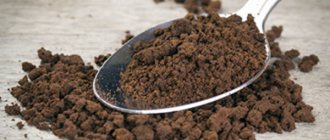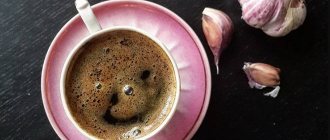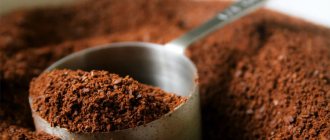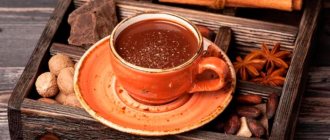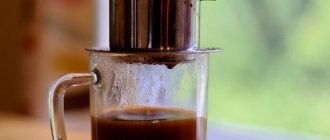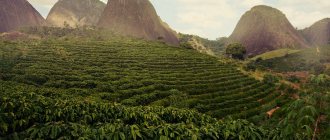Types of coffee
There are several varieties of the drink. In the ranking of the most delicious coffee, which type is in the lead? Undoubtedly this is Arabica. Its taste is soft and rich at the same time. Arabica is considered the world leader in production and consumption in ground form.
Robusta has a stronger taste with a slight noble bitterness. The cultivation of this variety of beans is not as widespread as the Arabica variety, but it is Robusta that is used for the production of instant drinks.
In addition to these most famous types of coffee, there are also less common ones:
- Liberica - this species has a tart and bitter taste, which is why it is rarely used in its pure form. Most often, Liberica serves as a flavoring additive to milder Arabica beans. It is difficult to find this species on sale; most often it can only be purchased in Africa, where it is grown.
- Excelsa is a rare type of grain that is grown in Vietnam, Congo, Kenya and the Philippines. It has a very specific aroma, which is why it is used as a flavoring additive to other types. It is used to produce a drink known as mocha.
- Maragojipe has large coffee beans. It has a strong, rich aroma.
On the open market you can find Arabica coffee, which differs in the types and tastes of coffee due to different roasting methods, as well as flavoring and aromatic additives.
How to make coffee
It all depends on which option you like and how much time you are willing to spend. We talk about classic methods of brewing coffee and the third wave alternative.
Cold Brew Tonic/www.shutterstock.com/g/AnastasiaNess
Turka is a copper flask with a handle for making Turkish coffee. The ground beans are poured with water and boiled until the coffee foam begins to rise. This drink tastes like an Americano, but in fact it is much stronger due to the fact that the water is in contact with the coffee itself for a long time.
Moka is an Italian device for making espresso. Water is poured into the bottom of the moka and ground coffee is placed into the filter in the middle. The device is placed on the stove, the water is heated and under pressure goes to the top, taking away the coffee taste and aroma.
A coffee machine is an electronic gadget that can prepare different coffee drinks. The degree of your involvement in the process depends on the type of machine: with some you just press a button, with others you will need to manually fill the coffee filter and froth the milk.
The AeroPress is a lightweight, portable device. Hot water with coffee is poured into a cylinder and manually pushed into a plastic flask with a special piston.
Hario V60 is a Japanese filter coffee device. Ground coffee is poured into a funnel with a paper filter, hot water is poured on top and moves in an internal spiral. The drink collects at the bottom of the flask.
Kalita is a mechanism that works on the hario principle. But both compartments of the gate have a flat bottom rather than a spiral one. The filter itself does not fit tightly to the funnel. Thanks to this, the water stays in contact with the coffee longer, and the coffee itself interacts more with the air.
A Chemex is a glass flask and funnel connected by a rim made of wood and leather. Water is similarly poured through a coffee filter. The drink is almost no different from the one prepared with Kalita and Hario.
Cold brew - ground beans are infused in cold water for a day and then filtered.
At home I make coffee using our carob coffee machine. The AeroPress is a cool thing for traveling. We took it to Iceland to drink fresh espresso in the mountains. The main thing is to take some boiling water with you into a thermal glass. In the summer I like to drink cold brew tonic, it's very refreshing. You need to grind the coffee coarsely, filter out the too fine fractions, then add water and let it sit for a day. When time has passed, pour through the filter, and then dilute the coffee concentrate with tonic - I like one part cold brew to two parts tonic.
Nastya Belousova
Espresso extraction from an AeroPress in Iceland / www.shutterstock.com/g/AnastasiaNess
Elite varieties
The taste characteristics of coffee depend not only on the type of beans, but also on their processing. Elite varieties of the drink are not only expensive, but also have a unique, memorable taste:
- Kopi Luwak is a variety of grains that is known for the fact that one of the stages of processing is its passage through the gastrointestinal tract of the musang animal. There it is fermented with gastric juice and civet, giving it a unique taste.
- Chon is a Vietnamese coffee variety that is processed in a similar way, although martens are used instead of musang. The cost of a kilogram of such grains reaches 11,800 rubles. (200 dollars).
- Black Ivory is a Thai drink whose grains are collected from elephant excrement. With this method of processing, coffee is free of bitterness and has light fruity notes.
- Coffee Yauco Selecto is an unusual variety that has a specific but pleasant taste. The cost reaches 2,900 rubles. ($50) per kilogram.
- Starbucks is a drink from a famous manufacturer. It has a bright, memorable taste with a pleasant sourness.
- Blue Mountain is a Jamaican coffee with a light and pleasant taste, devoid of any bitterness. Especially popular in Japan.
These varieties of grains are difficult to find on the open market, but they are worth trying for the unusual taste sensations.
Chocolate for those with a sweet tooth
Regardless of the type of beans, you can safely add dark, milk or white chocolate to your coffee. The same applies to its type: grated, melted, broken into pieces or melted.
Interesting! How to make foamy coffee at home
Depending on the flavor notes present in the drink, chocolate will help highlight them or create a new combination.
The mocha variety adds a bitter and milky appearance. In the first case, chocolate will add viscosity and tartness. In the second, on the contrary, it will soften the taste and add sweetness.
Coffee goes well with any form of sweetness. Don't be afraid to experiment and create your own variations.
Chocolate chips are sprinkled on top of the drink to give it an aesthetically complete look.
Coffee rating by country of origin
The taste of natural coffee is incomparable, which is why its beans are highly valued all over the world. However, there are several countries that are at the top of the ranking in terms of taste and quality characteristics of the resulting drink:
- Brazil is the largest country in the supply of quality coffee beans. There are about 40 varieties of Arabica that are produced in this state.
- Coffee beans produced in Guatemala are not as widespread as Brazilian varieties, but remain no less beloved by gourmets.
- The drink from Kenya has a currant flavor and a pleasant sour aftertaste.
- Coffee from Colombia has a pleasant, light taste. These beans are great for making refreshing coffee drinks.
Cuban, Caribbean and Yemeni drinks are also considered good. However, these countries are not the world leaders in grain production.
How and when do aromas arise?
There are 3 main segments in coffee aromas:
- enzymatic aromas. In Russian sources they are often called enzymatic;
- aromas of caramelization or “burnt sugar aromas” (sugar browning);
- aromas of dry distillation.
Aromas are formed during the three roasting phases that coffee beans go through.
Espresso aroma - the result
three phases of roasting coffee beans.
Enzymatic or enzyme flavors
This segment groups aromas that are determined by environmental factors affecting the coffee tree during its growth.
Such factors include: the amount and frequency of precipitation, temperature, amount of sun, site height, soil mineralization and density, and the presence of shading plants. All of the above affects what substances and in what quantities coffee beans can be stored.
The more diversity there is in the chemical elements, the more potential the grain has for developing flavors. This determines the difference in the price of raw coffee: quality has its price. Richer coffee varieties require more care, grow at higher altitudes, are more difficult to access by machinery and are therefore more difficult to grow compared to the huge plantations in the plains, where agricultural processes are mechanized.
The aromas of this group are formed at the early stage of roasting. They will be lost if frying is long. In dark varieties of coffee, they do not remain at all. This explains the trend towards light roasted coffee beans. But this does not mean that light roasting guarantees great taste. It all depends on the quality of the raw materials and proper roasting.
The main groups of aromas distinguished in the enzymatic segment: floral, fruity, herbal.
Caramelization flavors
One of the key chemical processes that occurs during roasting is the Maillard reaction, a chemical reaction between an amino acid and sugar that occurs when heated. In parallel with the Maillard reaction, caramelization occurs, which rearranges the sugar present in the coffee.
These processes create new aromas and consume chemicals that could potentially create other aromas. So, during the roasting process you can feel, for example, the aroma of vanilla, which disappears or turns into something else.
The determining factors in both processes are the temperature and duration of roasting.
In short, the longer the roasting, the simpler and more uniform the aroma becomes.
The main groups of flavors formed during the caramelization process: nutty, caramel, chocolate.
Dry distillation
The term "dry distillation" is a softened version of the combustion process of coffee beans that occurs in the last phase of roasting. During this phase, the cellular structures in the beans are burned and several (actually few) additional aromas are produced. At the same time, some of the aromas that arose in previous phases disappear.
Espresso coffee can be “dry distilled” to serve several purposes. Firstly, to hide or soften some unpleasant notes in the aroma. Secondly, it helps reduce the acidity of the future drink.
Based on the above, for high-quality grains, other methods of reducing acidity are usually used by roasting them in a gentle mode, preventing them from burning.
The main groups of aromas formed during the dry distillation process are: resinous, spicy, charcoal.
External signs of roasting phases
Coffee aromas are formed in three roasting phases. It is important to understand that there are no clear boundaries between the phases. The transition depends both on the temperature and duration of heating, and on the characteristics of the feedstock. The following factors play a role: the density of the grain (cellular structure), the water content in it, the temperature of the grains before roasting.
The “clicks and crackles” rule, proven by many roasters, helps to distinguish the roasting phases from each other. Loud clicking sounds are heard as the kernels expand and expand when heated, much like popcorn. These sound effects correspond to the caramelization phase. A slight constant cracking sound is heard when small cracks appear in the grain. This means that the grain has entered the dry distillation phase.
Rating of famous brands
These coffee brands are the most common in Russia. They can be found on the shelves of any store. Which coffee is the most delicious of the most affordable brands:
- Jardin is an optimally roasted Arabica coffee that has a bright coffee taste, making this brand loved by many fans.
- Kimbo is an Italian brand that offers quality drinks for every taste and budget.
- Gut! The brand is known for its high-quality coffee of both types - both Arabica and Robusta.
- Lavazza is an Italian brand that offers consumers both single-origin and various blends. In addition, the company produces a flavored drink.
- Malongo is a coffee produced in France. Coffee lovers note that the beans from this manufacturer produce excellent espresso.
These measures have different price categories, but are freely available, which is why they are loved by the population.
Something went wrong …
You have determined that the problem is not the coffee beans, the water, or the equipment. Happens. Brewing coffee is not as easy as it seems. Believe it or not, coffee can taste bad for other reasons.
The moment of optimal readiness has been missed
When, for example, tea leaves turn out stronger than necessary, nothing bad will happen. The strength of the tea can be adjusted with water. In the case of coffee, the situation is completely different. If the brewing time is too short or, on the contrary, too long, then we will end up with under- or over-concentrated coffee.
For example, brewing time for coffee using the percolation method is six to ten minutes. Thus, we are given a wide field for maneuver. So if you're planning on trying out a new recipe, you may need to experiment a little.
Tip: Change the brewing time little by little to find your taste.
You're brewing too much coffee
Brewing coffee “for later” is just as bad an idea as buying coffee in reserve. At first glance, you are hypothetically saving time in the future, but the best coffee is freshly brewed coffee.
Tip: Brew less coffee, but more often, especially when you are at home. By brewing just enough coffee for you (or your guests) to drink at a time, you'll enjoy a fresh brew every time.
Human factor
Even the best of the best make mistakes. It's great when you know what exactly you did wrong. If not, replay in your head the process of how you brewed coffee. Maybe you measured the water incorrectly. Perhaps somewhere you missed some small stage. But even in this case, you should not be upset. Next time you will be more careful.
Tip: Next time, try to write down your actions: each step, how much water and coffee you took, and even what temperature the water was. Don't stop if even after a second test brew the taste confuses you. Keep making adjustments to the process until you solve the problem.
You just didn't like this variety
Remember, it's all a matter of personal taste. Some types of coffee themselves may have a taste that is unpleasant to you personally. Don't force yourself to drink it.
Tip: Change the recipe, try different types of coffee beans, look for what you really like.
By now you already know (but not exactly) why coffee can taste bad.
After reading this, you might find it a little easier to make truly delicious coffee yourself. Brewing coffee can be a bit of a puzzle. The article describes only the most common reasons why the taste of the drink deteriorates. In fact, they are not limited to the thirteen listed above. Don't worry if you don't succeed.
Once again, mentally analyze the brewing process, check the coffee beans, take a closer look at the equipment and utensils. Make changes to one of the elements each time until the problem is resolved.
To become a coffee expert, a real barista, you need to go a long way and constantly work to improve your skills. In order to intuitively consider all the factors affecting the drink, constant practice is required. You will master the art of coffee brewing only if you work hard and persistently to solve problems and improve the taste of the drink.
Enjoy your coffee!
Strong coffee varieties
Despite the fact that Arabica remains the leader in consumption due to its mild taste, Robusta does not lose its leadership among lovers of stronger drinks. Robusta has a high caffeine content, in addition, it is from it that the instant drink is made.
Connoisseurs of a strong appearance should pay attention to the following varieties of grains:
- Robusta Uganda.
- Kubito.
- Sulawesi Toraha.
- Yemen Mocha.
In addition, the following strong blends are available for sale:
- Dead Wish is the leader in strength among all existing types. It is not for nothing that its name is translated as “Suicide Note”. This brand of coffee contains an explosive mixture of the strongest varieties. In addition, the caffeine content is 1.5 times higher than in espresso.
- Espresso IR is a strong drink with unique nutty notes that are formed during roasting using a special technology.
- Paganini is a strong blend of Arabica and Robusta.
These blends are difficult to find on the open market, so if you want stronger coffee, you should pay attention to varieties that are labeled “espresso.”
How does the origin of coffee affect its taste?
If you have been drinking coffee for a long time and regularly, then you have already formed your own personal preferences. And you already know what you like: the fruitiness of Ethiopian coffee, the balanced and sweet notes of Guatemala, or the spicy and earthy notes of Indonesian coffee.
Experienced coffee buyers believe that customers want to try different interesting flavors, so assessing the aroma by origin is valuable and necessary.
How to choose coffee?
What is the best coffee? How to choose the right grain so that it meets your expectations in terms of quality and taste? You should pay attention to the following points:
- Manufacturer country. The higher above sea level the grain is grown, the softer and lighter it will be. This concerns the taste of Arabica coffee, since almost all Robusta is grown in lowland areas.
- The degree of roasting is divided into light, medium and long. Light is characterized by softness and tenderness of taste, it is ideal for refreshing coffee drinks. Medium enhances the smell, but gives it bitterness. Long or French roasting makes the drink more aromatic, adding bitterness and astringency to it.
- Grinding degree. There are three degrees - coarse, medium, fine grinding. Coarse is used for cooking in a French press, fine is used for cooking in a Turk, medium is considered universal.
In addition, you should pay attention to freshness, because it also plays an important role in the taste characteristics of the resulting drink.
Your choice is plastic
A reusable coffee mug may be ideal for travel, but unlike ceramic and glass, plastic will absorb odors over time. And a subtle sense of smell will definitely catch it, which means the impression of coffee will be spoiled! The lids that are always paired with plastic (both disposable cups for cold coffee and reusable cups for hot coffee) interfere with the perception of such a pleasant aroma. Your nose won't benefit from coffee if you drink it from plastic cups.
It is known that we evaluate aromas in two ways: orthonasal (through the nose) and retronasal (when volatile substances “fly” to the receptors, passing behind the roof of the mouth while eating). So, according to Mr. Spence, “coffee is one of the few drinks where the orthonasal aroma we inhale is often more pleasant than the retronasal one.” The professor is perplexed: “Why are billions of coffees sold in glasses with a plastic lid that does not allow us to truly feel (hear, as experts would say) the aroma of the coffee?”
Drinking iced coffee from a plastic cup
Choice of ground coffee
Most often, coffee lovers prefer to buy already ground and packaged drinks. In order to choose the right coffee, you should pay attention to the following points:
- the beans may contain caffeine or may be decaffeinated;
- the packaging must be hermetically sealed;
- the date of manufacture should be as late as possible;
- The packaging should indicate the degree of grinding, roasting, and grade.
It should be remembered that after opening the pack, the contents should be poured into a hermetically sealed container.
Taste perception: test
Let's look at something sour, for example. The tongue will not be able to tell you what pH this substance has, 3 or 7 units. You will only be able to feel that this substance is more or less sour than the one you tried before.
It’s easy to verify this yourself. Take a few sips of water, bite off a slice of lemon, chew it well, and then take a few sips of the same water again. Surprisingly, the water will taste sweet, as if you had added a spoonful of sugar. The water has not changed, but your taste “reference point” has changed. It was she who strengthened the opposite taste: the sequence of tastes (neutral - sour - neutral) plays tricks on your perception. Just imagine what this means for anyone who drinks coffee with pancakes and maple syrup...
Your morning pancakes. Image owner: King's Row Coffee

